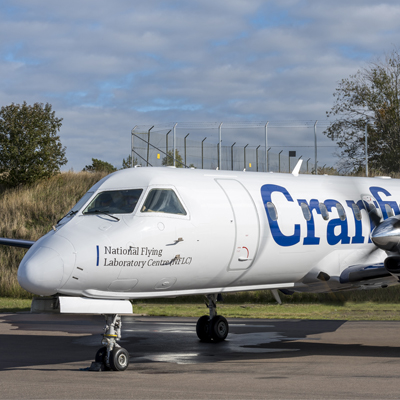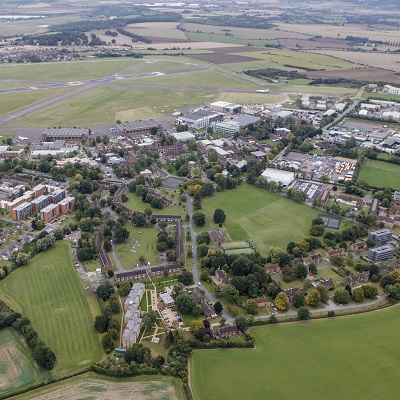Overview
- Start dateOctober
- DurationFull-time one year; part-time up to three years
- DeliveryTaught modules 40%, group project 20% (or dissertation for part-time students), individual project 40%
- QualificationMSc
- Study typeFull-time / Part-time
- CampusCranfield campus
Who is it for?
This course provides engineering, physics, computing, or mathematics graduates with advanced skills which can be applied to aviation, drone, security, defence, and aerospace industries. We also welcome students with industry experience and offer the course on a part-time basis for those looking to work whilst continuing in employment.
Why this course?
The Advanced Air Mobility Systems MSc is designed to equip you with the skills required to pursue a successful career in transforming the aviation industry, applying the knowledge learned to introduce new automated and autonomous solutions to improve the industry as a whole.
Taught through a unique combination of theoretical and practical-based sessions, you will cover subjects in ATM, Uncrewed Traffic Management (UTM), enabling sensor infrastructure (communications, navigation, surveillance), sensor fusion and artificial intelligence for autonomous systems. The MSc course content has been based on advice from the Industrial Advisory Board, comprising industrial representatives from big primes to small- and medium-sized enterprises. The Industrial Advisory Board also recommend thesis and project topics ensuring their real-world relevance, another effective differentiator in the job market. This allows you to familiarise yourself with companies from the Industrial Advisory Board and be exposed to their research interests, paving the way for potential job opportunities.
The Cranfield MSc in Advanced Air Mobility Systems is unique in that it offers a combination of subjects much sought-after in the aviation, air traffic, and drone industries, that are not covered in a single MSc course anywhere else, giving particular emphasis to the digitalised integrated architecture, the enabling sensor infrastructure (including communication, navigation, and surveillance) and intelligent algorithms, such as flight management and planning, and deconfliction. As a successful graduate of this MSc course, you will become conversant in key aspects of automation and autonomy in emerging crewed/uncrewed traffic management which places you at an advantage in today's competitive employment market.
A key feature of the MSc is the inclusion of a CAA approved UAV remote pilot competence course. The course incorporates a ground school element for flight planning – covering principles of flight, rules and regulations of the air, using aviation charts, risk assessment and meteorology – and flight training to provide basic pilot competence, including how to respond in an emergency and being able to operate safety features. Successful completion of the course allows students to fly small UAV’s in the Open Category.
Informed by industry
The MSc course content has been based on advice from the Industrial Advisory Board (IAB), comprising industrial representatives from big primes to small- and medium-sized enterprises. The relevant, competent and pro-active Industrial Advisory Board includes:
| Boeing UK | Connected Places Catapult |
| Thales | Spirent |
| BAE Systems | ANRA Technologies |
| NATS | Heathrow |
| SAAB | QinetiQ |
| FlugAuto | General Atomics Aeronautical Systems UK |
| Rolls-Royce |
Blue Bear Systems Research Ltd. |
| Lockheed Martin UK | Northrop Grumman |
| QuadSAT | HEROTECH8 |
| Altitude Angel | Indra UK |
Members of the Board not only continuously advise on updating the course content but also provide topics for individual research projects (IRPs). After the final oral exams in early September, all students present posters summarising their IRPs to the whole Industrial Advisory Board, thus exposing their work to seasoned professionals and potential employers. The IRPs benefit from our own lab where real autonomous vehicles can be designed and tested.
Course details
The MSc course consists of three weighted components, taught modules, and individual research project, and a group project. The taught course element includes eight taught compulsory modules, generally delivered from October to March. The eight modules cover the fundamentals of Air Traffic Management (ATM) and communications systems and progresses to the core subjects of AI for autonomous systems and Uncrewed Traffic Management (UTM).
The taught part of the course is followed by a Group Design Project (GDP) and individual research projects (IRPs). The GDP enables students to work as part of a team, develop project planning and management skills, and communications abilities, to design, implement, validate and test an advanced air mobility system component, applying the knowledge acquired in the taught modules and integrate the various methods learned.
Students are also supported in their learning and personal development through participation in: industry seminars, group poster sessions, group discussions, group presentations, video demonstrations, case studies, laboratory experiments, coursework, and project work. Students will receive hands-on experience accessing equipment and facilities within our Digital Aviation research and Technology Centre and Aerospace Integration Research Centre.
Course delivery
Taught modules 40%, group project 20% (or dissertation for part-time students), individual project 40%
Group project
The group design project facilitates the design, build, and operation of autonomous solutions for the emerging Advanced Air Mobility Systems market, modernised and integrated crewed/uncrewed Traffic Management, thus integrating and applying the knowledge students acquire in the taught modules. The group design project also aims to provide students with experience of working on a collaborative engineering project, within an industry structured team, developing transferable skills that include working in a team with members having diverse backgrounds and expertise, project management, and technical presentations.
Part-time students are encouraged to participate in a group project as it provides a wealth of learning opportunities. However, an option of an individual dissertation is available if agreed with the Course Director.
Individual project
Our industry partners sponsor individual research projects allowing you to choose a topic that is commercially relevant and current. Topics are chosen during the first teaching period in October and you begin work during the second half of the MSc course (May-August). The project allows you to delve deeper into an area of specific interest, taking the theory from the taught modules and joining it with practical experience.
Projects encompass various aspects of operations, not only concerned with design but including civil applications, architectures, systems, sensors, and other feasibility studies industry wishes to explore.
For the duration of the project, each student is assigned both a university and industry supervisor. In recent years, students have been based at sponsor companies for sections of their research and have been given access to company software/facilities.
During the thesis project, all students give regular presentations to the course team and class, which provides an opportunity to improve your presentation skills and learn more about the broad range of industry-sponsored projects.
For part-time students, it is common that their research thesis is undertaken in collaboration with their place of work.
Modules
Keeping our courses up-to-date and current requires constant innovation and change. The modules we offer reflect the needs of business and industry and the research interests of our staff and, as a result, may change or be withdrawn due to research developments, legislation changes or for a variety of other reasons. Changes may also be designed to improve the student learning experience or to respond to feedback from students, external examiners, accreditation bodies and industrial advisory panels.
To give you a taster, we have listed the compulsory and elective (where applicable) modules which are currently affiliated with this course. All modules are indicative only, and may be subject to change for your year of entry.
Course modules
Compulsory modules
All the modules in the following list need to be taken as part of this course.
Induction
| Module Leader |
|
|---|---|
| Aim |
|
| Syllabus |
|
| Intended learning outcomes |
On successful completion of this module you will be able to:
|
Introduction to Advanced Air Mobility
| Module Leader |
|
|---|---|
| Aim |
|
| Syllabus |
|
| Intended learning outcomes |
On successful completion of this module you should be able to:
|
Statistical Learning Methods
| Aim |
|
|---|---|
| Syllabus |
|
| Intended learning outcomes |
On successful completion of this module you should be able to:
|
Air Traffic Management Systems
| Aim |
The aim of this module is to provide an understanding of the current and future air traffic management (ATM) and air traffic control (ATC) systems, their functional architectures, main algorithms and applications. Both the regulatory and technical context will be explained, with an emphasis towards ATM digitalisation and increased automation. The module also aims to discuss current ATM standards and technology applied in the systems and to review the future concepts as described by SESAR/NextGen. Finally, an overview of the appropriate tools to develop and assess ATM components will be presented, enabling students to critically evaluate the performance of an ATM function. |
|---|---|
| Syllabus |
Overview of current ATC systems:
Future Air Navigation System:
Air Traffic Management Key Performance Indicators: |
| Intended learning outcomes |
On successful completion of this module you should be able to:
|
Aerial Communications Systems
| Module Leader |
|
|---|---|
| Aim |
|
| Syllabus |
Overview of airborne communications:
Aeronautical Communication:
Communications system design:
Antennas design:
Communications Networking:
Case study:
|
| Intended learning outcomes |
On successful completion of this module you should be able to:
|
Uncrewed Traffic Management
| Module Leader |
|
|---|---|
| Aim |
|
| Syllabus |
Detailed analysis of current UTM ecosystem
Definition of UTM Services
Detailed analysis of Enabling Technologies |
| Intended learning outcomes |
On successful completion of this module a you should be able to:
|
Data Analytics and Visualisation
| Module Leader |
|
|---|---|
| Aim |
|
| Syllabus |
|
| Intended learning outcomes |
On successful completion of this module you should be able to:
|
Artificial Intelligence for Autonomous Systems
| Module Leader |
|
|---|---|
| Aim |
|
| Syllabus |
|
| Intended learning outcomes |
On successful completion of this module you should be able to:
|
Guidance and Navigation for Autonomous Systems
| Aim |
|
|---|---|
| Syllabus |
• Introduction on navigation and guidance systems;
• Path planning for autonomous systems • Path following for autonomous systems • UAV (Unmanned Aerial Vehicle) guidance systems; • Guidance approaches: conventional guidance such as PN (Proportional Navigation), geometric guidance, and optimal guidance; • Navigation approaches: navigation systems, GNSS (Global Navigation Satellite System), terrain based navigation, SLAM (Simultaneous Localisation and Mapping); • Cooperative guidance and collision avoidance. |
| Intended learning outcomes |
On successful completion of this module you should be able to:
|
Teaching team
You will be taught by Cranfield's experienced academic staff. Our staff are practitioners as well as tutors, with clients which include the members of the Industrial Advisory Board and beyond. Knowledge gained working with our clients is continually fed back into the teaching programme, to ensure provision of durable and transferrable skills practised on problems relevant to industry. Additionally, experienced members of the Industrial Advisory Board deliver industrial seminars in which they share their experience and explain the research and development proprieties of their companies. The Course Director for this programme is Dr Hae In Lee.
It is becoming clear that Advanced Air Mobility [encompassing subject areas such as digitalization of Air traffic Management (ATM), Unmanned Aircraft Systems Traffic Management (UTM) and Urban Air Mobility (UAM)] will be a major transformative factor in the aerospace, defence, and security sectors.
In the UK, and wider in the EU, we perceive a shortage of qualified people trained in Advanced Air Mobility (AAM), specifically in autonomy and automation in ATM, UTM and UAM. In particular, we would need not only engineers but also software and application developers with a deep understanding of the AAM subject areas described above, tailoring them to tackle ambitious industrial problems of enabling ubiquitous UAS operations and their seamless integration into conventional manned aviation.
We need employees able to address complex, real-world problems, who have state-of-the-art ATM, UTM and UAM expertise, and who are equipped to work collaboratively across traditional disciplinary boundaries. This rounded skillset is of high importance to us, and the MSc course in AAM is perfectly suited to fill this gap.
Your career
The industry-led education that you will receive on this MSc will place you among the most desirable candidates for recruitment into global enterprises through to smaller innovative start-ups looking for the brightest talent. Industrial contact may take place even from the Individual Research Project that enables familiarisation with our Industry Advisory Board.
Graduates from the MSc have gone into roles including:
- Autonomous systems engineer
- Design engineer
- Research Assistant in Advanced Air Mobility
- Applied Vision Control (KTP Associate)
Companies that employ our graduates include:
- BAE Systems
- Thales
- SAAB
- Boeing
- NATS
- Heathrow Airport
- Inmarsat
As a graduate from this course you will be equipped with the advanced skills which could be applied to the aviation, air traffic, air transport, security, defence, and aerospace industries. This approach offers you a wide range of career choices in industry, and some decide to continue their education through PhD studies available within Cranfield University or elsewhere.
Cranfield’s Career Service is dedicated to helping you meet your career aspirations. You will have access to career coaching and advice, CV development, interview practice, access to hundreds of available jobs via our Symplicity platform and opportunities to meet recruiting employers at our careers fairs. Our strong reputation and links with potential employers provide you with outstanding opportunities to secure interesting jobs and develop successful careers. Support continues after graduation and as a Cranfield alumnus, you have free life-long access to a range of career resources to help you continue your education and enhance your career.
Part-time route
We welcome students looking to enhance their career prospects whilst continuing in full-time employment. The part-time study option that we offer is designed to provide a manageable balance that allows you to continue employment with minimal disruption whilst also benefiting from the full breadth of learning opportunities and facilities available to all students. The University is very well located for visiting part-time students from all over the world and offers a range of library and support facilities to support your studies.
As a part-time student you will be required to attend teaching on campus in one-week blocks, for a total of 9 blocks over the 2-3 year period that you are with us. Teaching blocks are typically run during the period from October to March, followed by independent study and project work where contact with your supervisors and cohort can take place in person or online. Students looking to study towards the MSc will commence their studies in the October intake whereas students who opt for the research-based MRes may commence either in October or January.
We believe that this setup allows you to personally and professionally manage your time between work, study and family commitments, whilst also working towards achieving a Master's degree.
How to apply
Click on the ‘Apply now’ button below to start your online application.
See our Application guide for information on our application process and entry requirements.











